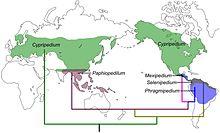| Lady's slipper orchid | |
|---|---|
 | |
| Slipper orchid of the genus Paphiopedilum | |
| Scientific classification | |
| Kingdom: | Plantae |
| Clade: | Tracheophytes |
| Clade: | Angiosperms |
| Clade: | Monocots |
| Order: | Asparagales |
| Family: | Orchidaceae |
| Subfamily: | Cypripedioideae |
| Genera | |
| See text and Taxonomy of the orchid family. | |
 | |
| Cypripedioideae genera range | |
Cypripedioideae is a subfamily of orchids commonly known as lady's slipper orchids, lady slipper orchids or slipper orchids. Cypripedioideae includes the genera Cypripedium, Mexipedium, Paphiopedilum, Phragmipedium and Selenipedium.[1] They are characterised by the slipper-shaped pouches (modified labella) of the flowers – the pouch traps insects so they are forced to climb up past the staminode, behind which they collect or deposit pollinia, thus fertilizing the flower. There are approximately 165 species in the subfamily.

Taxonomy
Unlike most other orchids, slipper orchids have two fertile anthers — they are "diandrous". For that reason, experts have debated whether this clade should be classified within the orchid family (Orchidaceae), or whether they should compose a separate family altogether called Cypripediaceae.[2] Around the year 2000, molecular phylogenetics and DNA sampling have come to play an increasingly important role in classification.[3] This has led to the conclusion that recognition of a distinct family Cypripediaceae would be inappropriate.[4]

The subfamily Cypripedioideae is monophyletic and consists of five genera:
- Cypripedium, found across much of North America, as well as in parts of Europe (one species), Africa (only in Algeria has been discovered in 2019[5]) and Asia. The state flower of Minnesota is the showy lady's slipper (Cypripedium reginae); the pink lady's slipper (Cypripedium acaule) is the official flower of the Canadian province of Prince Edward Island.
- Mexipedium, a monotypic genus, consisting of a single species that was found in a single locality in Oaxaca, Mexico.
- Paphiopedilum, found in the tropical forests of southeast Asia reaching as far north as southern China. Paphiopedilum is quite easy to cultivate and therefore is popular among orchid enthusiasts. In fact, over-collection of this genus has been so extensive that many species are now sub-viable in their natural habitats.
- Phragmipedium, found across northern South and Central America, is also easy to cultivate as it requires lower temperatures than Paphiopedilum, eliminating the need for a greenhouse in many areas.
- Selenipedium, found in Central and South America.
References
- ^ Cash, C. (1991). The Slipper Orchids. Timber Press. ISBN 0-88192-183-1.
- ^ Rasmussen, F. N. 1985. "Orchids". In R. M. Dahlgren, H. T. Clifford, and P. F. Yeo [eds.], The families of the monocotyledons. Springer Verlag, Berlin.
- ^ K. W. Dixon, S. P. Kell, R. L. Barrett and P. J. Cribb (eds) 2003. "DNA Data and Orchidaceae Systematics: A New Phylogenetic Classification". Orchid Conservation. pp. 69–89. Natural History Publications, Kota Kinabalu, Sabah.
- ^ Górniak, M.; Paun, O.; Chase, M. W. (2010). "Phylogenetic relationships within Orchidaceae based on a low-copy nuclear coding gene, Xdh: Congruence with organellar and nuclear ribosomal DNA results" (PDF). Molecular Phylogenetics and Evolution. 56 (2): 784. doi:10.1016/j.ympev.2010.03.003. PMID 20211743. Archived from the original (PDF) on 2019-12-31.
- ^ Walid, Nemer & Rebbas, Khellaf & Krouchi, Faiza. (2019). Découverte de Cypripedium calceolus (Orchidaceae) au Djurdjura (Algérie), nouvelle pour l’Afrique du Nord. Flora Mediterranea. 29. 207-214. 10.7320/FlMedit29.207.
Further reading
- Cox, A. V., A. M. Pridgeon, V. A. Albert, and M. W. Chase. 1997. Phylogenetics of the slipper orchids (Cypripedioideae: Orchidaceae): nuclear rDNA ITS sequences. Plant Systematics and Evolution 208: 197–223. Abstract
- Pridgeon, A. M.; Cribb, P. J.; Chase, M. W. & F. N. Rasmussen (1999): Genera Orchidacearum Vol. 1, Oxford U. Press. ISBN 0-19-850513-2